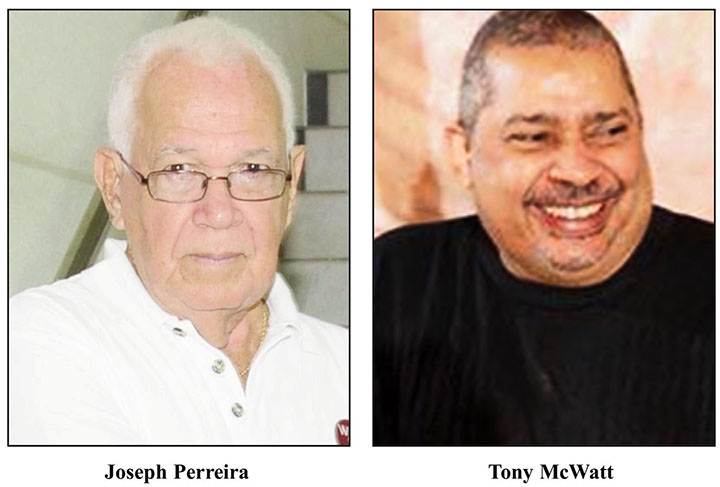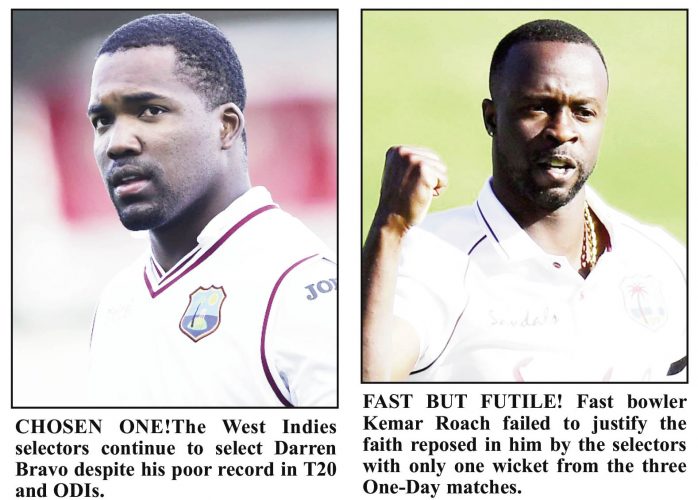By Tony (McWatt) and Reds (Perreira)
So India has yet again comprehensively defeated the West Indies in an ODI Series. This shouldn’t have come as much of a surprise to anyone as that has now been the trend for almost a decade and a half. What would have been distasteful to all West Indies cricket fans and followers, however, were the colossal margins of defeat in each of the three matches played. India won the first match by six wickets and the second by 44 runs. India’s 98-run victory margin in the final match of the series was the widest of all three.
The West Indies’ abject failure to provide India with anything more than the meekest of opposition during the series, can now be blamed, almost entirely, on the failure of its batting unit to register competitive scores in any of the three matches. The bowlers were also, however, guilty on occasion of serving up a fair share of boundary balls, as well as bowling too many wides.
Taking first strike in the first match the West Indies were bundled out for 176 in 43.5 overs. In the second, chasing India’s posted 237/9, they only managed to reach 193 all out in 46.5 overs. Their batting display in the third and final match was even more abysmal, 169 all out in 37.1 overs.
A most accurate and revealing reflection of the West Indies batting inadequacies during the series was the repeated loss of early top-order wickets. In the first ODI the West Indies lost its first five wickets for only 71 runs. In the second and third matches the score by which the fifth wicket had fallen was instructively identical 76/5.
As a further reflection of the inadequacies of the West Indies batting, and especially those of its top order, the three highest rankings on the series averages were those of the team’s middle – lower-order allrounders. Odean Smith led the rankings with 60 runs from two innings at an average of 30.00. Alzhari Joseph was second with 49 runs from three crease appearances for a 24.50 average, and Jason Holder was third with 65 from three, average 21.66
Holder’s miserly 65-run aggregate was, incredibly, the highest among all the West Indies batsmen. The aggregates and associated averages of the West Indies top five batsmen were far more in sync with numbers that would be called at a Bingo game, than those that would be expected of supposedly top-class batsmen in a three-match tournament.
In order of their respective appearances at the crease, the following are the actual series returns of the West Indies top-order batsman. Brandon King scored 45 runs from his three innings batted for a 15.00 average. His opening batting partner Shai Hope, the West Indies highest internationally ranked ODI batsman, had even poorer returns, compiling just 40 runs from three3 innings batted for a 13.33 average.
Darren Bravo, whose inclusion to the squad had been regarded as somewhat controversial given the paucity of his recorded scores within the past four years, failed abjectly to justify the selectors expressed faith in his abilities. Bravo’s returns from his three innings batted were a most disappointing 38 runs at an average of 12.66.
Shamarh Brooks batting at four scored 56 runs at an average of 18.66. Stand-in skipper Nicholas Pooran, who took over the captaincy reins following yet another Kieron Pollard injury-related withdrawal, posted 61 runs from his three innings for a series average of 20.33.
As indicated, Bravo’s dismal returns would have been a major disappointment to the Desmond Haynes-led West Indies selection panel. Despite all the evidence which existed to suggest that they were taking a huge gamble in doing so, Haynes and his fellow selectors had placed their faith in Bravo’s obvious batting talents to re-emerge during the series, by means of his recapturing of his long lost form. His failure to do so, must surely now have placed his chances for inclusion to future West Indies squads in serious doubt.
Haynes et al would also have expected far greater success from his lead bowler Kemar Roach and would not have been at all pleased by the seamer’s actual series returns. Having played in all three matches, Roach only managed to capture a solitary wicket for 122 runs in 20 overs bowled at an unimpressive economy rate of 6.10. This after Haynes, in explaining the selection, had expressed his panel’s confidence in Roach’s capacity to transfer his well-proven abilities to capture early wickets in Tests, to the much shorter ODI 50 over format matches.
The embarrassment of the West Indies performances during the series, and especially those of its top-order batsmen, will now undoubtedly give cause for Head Coach Phil Simmons and his support staff to come under further scrutiny. In some quarters calls are already being made for the entire coaching cadre to be dismissed and replaced before the commencement of the England Test series.
Despite the doom and gloom effects of the India ODI series, there still were some needles in a haystack positives that can be derived from the West Indies performances. Odean Smith’s ferocious lower-order hitting was suggestive of the West Indies having identified a suitable white-ball cricket all-rounder replacement for Andre Russell. Joseph’s admirably quick and efficiently penetrative bowing was also extremely encouraging. As was Haydn Walsh’s, wicket-taking, leg-spin bowling in the one match he played.
It was pity, especially in the light of Darren Bravo’s repeated failures, that Nkrumah Bonner wasn’t given a chance to play in any of the matches. A selection decision which made absolutely no sense, and for which it will indeed be interesting to hear Head Coach Phil Simmons’ explanation.
The ODI series having now been completed, attention will turn to the forthcoming three-match T20 Series between the two teams. T20 supposedly being the West Indies’ strongest format, one would hope that their performances during the forthcoming Series will at the very least be far more competitive than they were in the ODI matches.
Back at home, within the region itself, the February 9 – 12 first-round matches of this year’s Four Day Championships will have been completed before the India-West Indies T20 series actually commences. In that regard, Cricket West Indies is now deserving of the highest praise for its provided live televised coverage of each and every one of the Regional Four Day Matches. The coverage, which was started several years ago, has improved commendably with each subsequent staging of the tournament.
With the West Indies scheduled to engage England in a three Test series, which begins in Antigua on March 8 before subsequently moving to Barbados and eventually Grenada for the second and third matches, performances during the Regional Championships could possibly open some Test selection doors, as well closing others. It will, therefore, be very interesting to see what impact if any the respective performances of players during the Regional Four day Championships has on the West Indies squad for the Tests, when it is eventually chosen.
Much to look forward to in the weeks ahead.
About The Writers:
Guyana-born, Toronto-based, Tony McWatt is the Publisher of both the WI Wickets and Wickets monthly online cricket magazines that are respectively targeted towards Caribbean and Canadian readers. He is also the only son of the former Guyana and West Indies wicket-keeper batsman the late Clifford “Baby Boy” McWatt.
Guyana-born Reds (Perreira) has served as a world-recognized West Indies Cricket Commentator for well over fifty years. Reds made his broadcasting debut during the 1971 West Indies-India Test Series, and has commentated on hundreds of matches since then!




